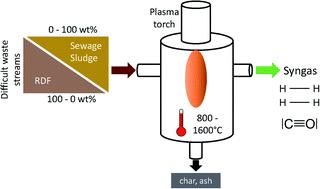当前位置:
X-MOL 学术
›
Sustain. Energy Fuels
›
论文详情
Our official English website, www.x-mol.net, welcomes your feedback! (Note: you will need to create a separate account there.)
Equilibrium modeling of thermal plasma assisted co-valorization of difficult waste streams for syngas production
Sustainable Energy & Fuels ( IF 5.6 ) Pub Date : 2021-07-27 , DOI: 10.1039/d1se00998b Vineet Singh Sikarwar 1, 2, 3 , Annika Reichert 4 , Michael Pohorely 2 , Erik Meers 3 , Newton Libanio Ferreira 5 , Michal Jeremias 1
Sustainable Energy & Fuels ( IF 5.6 ) Pub Date : 2021-07-27 , DOI: 10.1039/d1se00998b Vineet Singh Sikarwar 1, 2, 3 , Annika Reichert 4 , Michael Pohorely 2 , Erik Meers 3 , Newton Libanio Ferreira 5 , Michal Jeremias 1
Affiliation

|
The rising quantities of difficult waste streams are a global concern. Prudent utilization of difficult wastes such as sewage sludge (SS) or refuse derived fuel (RDF) can be a small but crucial step to answer the challenges of waste management coupled with the fulfillment of global energy requirements. Lately, thermal plasma is employed globally to process difficult waste streams because of its several inherent advantages including the potential to produce H2-rich syngas. In this investigation, an equilibrium model was developed with the H2O–Ar stabilized DC arc plasma employing RDF and SS with an objective to assess the optimal process parameters, gas yield, distribution of syngas components and reactor efficiency. The influence of reactor temperature (800 to 1600 °C at SS 30 wt%) and sludge content (0 to 100 wt% at 1200 °C) on syngas constituents, gas yield, LHV, residual carbon and ash was evaluated. The maximum gas yield was noticed as 0.83 kg gas per kg fuel at 1200, 1400 and 1600 °C with a LHV of 11 MJ N−1 m−3. Maximum H2 and CO volume fractions of 62 and 34 respectively were also observed at 1200, 1400 and 1600 °C. The maximum H2 was obtained as 67 vol% at 0 wt% SS whereas the minimum (43 vol%) was achieved at 100 wt% SS. Highest amounts of residual carbon (0.20 kg kg−1 fuel and 0.35 kg kg−1 fuel) were observed at 800 °C and 0 wt% SS, respectively. The highest reactor efficiency of 53% was realized at 100 wt% RDF (the comparison was performed at 1200 °C). The results of the investigation are encouraging to employ thermal plasma as potentially sustainable and environmentally friendly technology to co-valorize difficult waste streams.
中文翻译:

用于合成气生产的困难废物流的热等离子体辅助共价的平衡建模
越来越多的困难废物流是全球关注的问题。谨慎利用污水污泥 (SS) 或垃圾衍生燃料 (RDF) 等难处理废物是应对废物管理挑战以及满足全球能源需求的一个小而关键的步骤。最近,热等离子体在全球范围内被用于处理难处理的废物流,因为它具有几个固有的优势,包括生产富含H 2 的合成气的潜力。在这项研究中,平衡模型是用 H 2O-Ar 稳定直流电弧等离子体采用 RDF 和 SS,目的是评估最佳工艺参数、气体产量、合成气组分的分布和反应器效率。评估了反应器温度(800 至 1600 °C,SS 30 wt%)和污泥含量(1200 °C 时 0 至 100 wt%)对合成气成分、气体产率、LHV、残余碳和灰分的影响。在 1200、1400 和 1600 °C 下,最大气体产量被注意到为 0.83 kg 气体/kg 燃料,LHV 为 11 MJ N -1 m -3。在 1200、1400 和 1600 °C 时也观察到最大 H 2和 CO 体积分数分别为 62 和 34。最大 H 2在 0 wt% SS 时获得 67 vol%,而在 100 wt% SS 时达到最小值(43 vol%)。分别在 800 °C 和 0 wt% SS 下观察到最高量的残留碳(0.20 kg kg -1燃料和 0.35 kg kg -1燃料)。在 100 wt% RDF 下实现了 53% 的最高反应器效率(比较在 1200 °C 下进行)。调查结果令人鼓舞,采用热等离子体作为潜在的可持续和环境友好技术来共同评估困难的废物流。
更新日期:2021-08-13
中文翻译:

用于合成气生产的困难废物流的热等离子体辅助共价的平衡建模
越来越多的困难废物流是全球关注的问题。谨慎利用污水污泥 (SS) 或垃圾衍生燃料 (RDF) 等难处理废物是应对废物管理挑战以及满足全球能源需求的一个小而关键的步骤。最近,热等离子体在全球范围内被用于处理难处理的废物流,因为它具有几个固有的优势,包括生产富含H 2 的合成气的潜力。在这项研究中,平衡模型是用 H 2O-Ar 稳定直流电弧等离子体采用 RDF 和 SS,目的是评估最佳工艺参数、气体产量、合成气组分的分布和反应器效率。评估了反应器温度(800 至 1600 °C,SS 30 wt%)和污泥含量(1200 °C 时 0 至 100 wt%)对合成气成分、气体产率、LHV、残余碳和灰分的影响。在 1200、1400 和 1600 °C 下,最大气体产量被注意到为 0.83 kg 气体/kg 燃料,LHV 为 11 MJ N -1 m -3。在 1200、1400 和 1600 °C 时也观察到最大 H 2和 CO 体积分数分别为 62 和 34。最大 H 2在 0 wt% SS 时获得 67 vol%,而在 100 wt% SS 时达到最小值(43 vol%)。分别在 800 °C 和 0 wt% SS 下观察到最高量的残留碳(0.20 kg kg -1燃料和 0.35 kg kg -1燃料)。在 100 wt% RDF 下实现了 53% 的最高反应器效率(比较在 1200 °C 下进行)。调查结果令人鼓舞,采用热等离子体作为潜在的可持续和环境友好技术来共同评估困难的废物流。



























 京公网安备 11010802027423号
京公网安备 11010802027423号